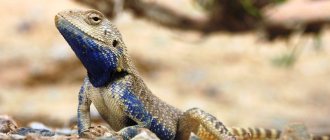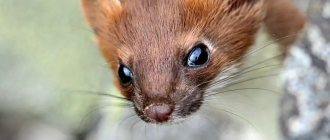Characteristics and description
All members of the family are nocturnal. At dusk, the animal goes around its area, and at dawn returns to the shelter. Hedgehogs jealously guard their personal territory and can express dissatisfaction with a relative who has entered their area with loud snorting and hissing.
A hedgehog's burrow is usually located in bushes or in the roots of a tree. Often, hedgehogs occupy rodent holes left by previous owners. For convenience, the chamber in the shelter is lined with fallen leaves and moss.
In case of danger, a hedgehog can reach speeds of up to 10 km/h, but in most cases it does not run away, but curls up into a ball with needles sticking out in different directions.
Adaptation to the environment is manifested in the following:
- well-developed sense of smell and hearing allows you to lead a nocturnal lifestyle;
- with the help of special longitudinal and circular muscles, the animal pulls its muzzle towards its hind limbs, and the protective armor of thorns covering its sides and back reduces the likelihood of becoming prey for predators;
- the ability to hibernate is necessary in order to survive the cold season, when the food supply is completely absent.
What they look like
The appearance of all representatives of the hedgehog family has the following common features:
- the body is round and elongated, the back and sides are covered with needles;
- the tarsi are thin, the hind legs are longer than the fore ones;
- the tail is small, length does not exceed 1-2 cm;
- the muzzle is elongated and pointed, with black shiny eyes and nose;
- there are 36 small sharp teeth in the mouth.
The color is dominated by black, brown, gray and white shades.
Defense mechanism
The hedgehog's fur and quills evolved to protect the animal from the cold and natural enemies. The sharp needles covering most of the animal's body are modified fur. They are durable, smooth and hollow inside. Young hedgehogs have about 3,000 spines; the spiny armor of an adult hedgehog consists of 8-9 thousand spines.
The quills grow, just like fur, from follicles. Periodically they fall out, and new ones grow in their place within 10-12 months. The position of the needles can change due to contraction of the subcutaneous muscles. In times of danger, the prickly cover, pressed to the body, rises on end, while the needles are directed in different directions and are at different angles to each other. The prickly animal curled up into a ball is reliably protected from many predators.
How to distinguish a hedgehog from a hedgehog by appearance
Sexual dimorphism in animals is manifested only in the structure and location of the genitals. In females, the urethra is located near the anus. In males, the distance between the genitals and the anus is 2-2.5 cm. In addition, in females, the five pairs of nipples located on the abdomen are more noticeable.
BAT
Appearance and structure
The structure and appearance of hedgehogs varies depending on the subfamily, genus and specific species. The body length of hedgehogs can be 10 or 45 cm (some gymnuras reach this length). The tail can be short (1 cm) and very long (21 cm). Weight from several hundred grams to 1.5 kg.
Hedgehogs have a strong physique, while gymnuridae are more fragile. In the latter, the neck can be clearly distinguished; in hedgehogs, it is not visible at all under the needle-like cover. In both subfamilies the tip of the muzzle is elongated and mobile. This is a characteristic feature of insectivores.
Hedgehogs have well-developed organs of vision and hearing, and have five-toed and sometimes four-toed limbs. The skin does not have sweat glands. The hair on the face is short, on the sides and belly it is longer. The longest one is on the back, and in hedgehogs the main part is transformed into needles. Vibrissae short.
The skull of hedgehogs is shortened and wide, while that of gymnurids is narrower. Teeth in number from 28 to 44 pieces. The development of canines and incisors depends on the type of food and varies from species to species. The spine has cervical, thoracic, lumbar, sacral and caudal parts.
The digestive tract is notable for its single-chamber stomach and the absence of a cecum. Females have a bicornuate uterus and 2-5 pairs of nipples. In males, the location of the testes is intra-abdominal.
Types of hedgehogs
The group of true hedgehogs includes five genera. Let's take a closer look at them.
African
The range extends to the African continent. The genus consists of four species. The largest is the Algerian hedgehog. You can recognize it by its relatively large ears and light, almost white fur.
The genus also includes an artificially bred hybrid - the African dwarf white-bellied hedgehog.
Eurasian
Eurasian hedgehogs live throughout Europe, western and central Asia. Unlike most of its relatives, the Eastern European hedgehog can live in semi-deserts and foothills, rising to an altitude of 1100 m above sea level.
A small population of the European subspecies was introduced to New Zealand, where it successfully established itself.
Eared
The genus united species living in hot climates. A characteristic feature of all representatives of the group are large, long ears, which are necessary for animals to accelerate heat exchange.
The eared hedgehog has the largest auricles: the distance from the base to the tip of the ear reaches 5 cm.
Steppe
The genus includes only two species: Chinese and Daurian hedgehogs. The range covers the territory of Mongolia, northeast China and some eastern regions of Russia. Steppe hedgehogs can be distinguished from their relatives by the shape of their needles: their surface is covered with longitudinal grooves.
Long-spined
Long-spined or dark-spined hedgehogs are distinguished by a very dark, almost black color and a needle length reaching 4 cm. The Ethiopian subspecies has a strip of skin on its forehead that is not covered with fur and spines.
Rat
Hedgehogs also include gymnurs, or rat hedgehogs. In appearance, they bear little resemblance to hedgehogs and are closer to large rodents: the head is large, the body is covered with coarse fur without spines, the tail is long and hairless.
Range and habitat
The habitat of the European hedgehog is quite wide; it lives:
- in the European part of Russia;
- in Western Siberia;
- Kazakhstan;
- Western and Central Europe;
- in southern Scandinavia;
- in New Zealand;
- Asia Minor;
- on the British islands;
- in northern and northeastern China.
Hedgehogs prefer to settle on the edges, in deciduous mixed forests, copses, grassy plains, and in clearings with dense thickets of grass and shrubs. They also inhabit steppes and deserts, and river floodplains. Hedgehogs avoid swampy areas and dense coniferous forests.
Hedgehogs also often live near human settlements: in parks, squares, garden plots, and fields with thick grass. They often come out to humans due to lack of food, unfavorable conditions, or fires.
Gardeners often feed the prickly guest and install a hedgehog house on the site. A wild hedgehog is quite easy to tame. A tamed and fed hedgehog settles on the site and can live for several years.
It is worth knowing that hedgehogs can be dangerous to both humans and pets. Hedgehogs are carriers of many diseases, including rabies.
If you meet a hedgehog in the morning or afternoon, when the sun is still high, you should be wary of such an animal. This is often the first sign that the animal may be sick. Also, hedgehog quills are very dangerous.
In addition to the fact that they can be painfully scratched, many parasites live among the spines on a hedgehog’s body, from fleas to ticks. A hedgehog, making its way through the thick grass, brushes off all the parasites on its body. Therefore, it is not worth taking a wild hedgehog for home keeping.
In nature, hedgehogs rarely build nests or dig holes. They are lazy and arrogant animals. Hedgehogs have rather short legs, which make it difficult to dig a hole, so they often occupy other people's holes. They line the bottom with dry grass and leaves, and then trample the surface.
Hedgehogs also often build nests in thick grass and bushes, live in deep holes and between thick tree roots.
Dimensions
Below are the dimensions and maximum weight of some members of the family.
| Name | Body length, cm | Weight, g |
| Stepnoy | 35 | 1400 |
| Eastern European | 35 | 1200 |
| Amursky | 30 | 1000 |
| Somali | 20 | 600 |
| Indian | 17 | 500 |
| Collared | 14 | 300 |
Where do they live?
Hedgehogs are distributed throughout the African continent, inhabit almost all regions of Europe, and are found in Asia with the exception of the southeastern part of the continent.
Hedgehogs are not found in America or on the Australian continent.
Where live
Hedgehogs prefer to settle in savannas and steppes covered with dense vegetation, in forests, where they choose partially open places: edges, clearings, clearings. You can also meet hedgehogs near rivers or lakes.
Hedgehogs avoid wetlands, too dense, impenetrable forests, deserts and foothills.
BADGER
Subfamily Hedgehogs
The subfamily of hedgehogs (or true hedgehogs) unites hedgehogs in the usual sense. These are tightly built, small-sized, short-legged animals with a short tail. The entire surface of their back is covered with hairs (needles) modified to a hard state, mixed with regular fur. Just under the skin of hedgehogs there are muscles, when contracted, the animals can curl up into a ball in case of danger.
Representatives of this subfamily are distributed in Africa, Europe and southern Asia. They were brought to New Zealand specifically. They are not found at all in North and South America, Australia and Madagascar.
Genus African hedgehogs
White-bellied hedgehog
Algerian hedgehog
South African hedgehog
Somali hedgehog
Genus Eurasian hedgehogs
Amur hedgehog
Eastern European hedgehog
collared hedgehog
Genus Steppe hedgehogs
Daurian hedgehog
Chinese hedgehog
Genus Long-spined hedgehogs
Ethiopian hedgehog
Dark-spined hedgehog (Bald hedgehog or long-spined hedgehog)
Indian hedgehog
How do they winter
Hedgehogs that live in temperate climates hibernate during the cold season. Before leaving for the winter, they feed intensively, gaining fat. To survive the winter, an animal needs to accumulate up to 300-500 grams of body fat. 2-3 days before bedtime, the animal stops feeding in order to cleanse the intestines.
The time when hedgehogs hibernate depends on climatic conditions. This usually happens in October, when the air temperature drops below +10 degrees, and frosts occur at night.
The hedgehog sleeps until April. During hibernation, his body temperature drops to +1-2 degrees, and his pulse drops to 20-40 beats per minute.
The awakening occurs in April, but the animal is in no hurry to leave the hole, waiting until the air warms up enough.
Hedgehogs: keeping in captivity
Most of us are accustomed to close proximity to feathered and four-legged friends. People willingly share shelter with parrots and canaries, cats and dogs, ferrets and decorative rodents.
flickr/Adam Foster
There is also a place next to humans for hedgehogs - prickly little and agile forest inhabitants who, with proper care, care and affection, can become wonderful pets. But first things first, and speaking about how to keep a hedgehog at home, first of all, you should find out where hedgehogs come from in the homes of modern animal lovers.
flickr/richard.heeks
Question of acquisition
Catching a hedgehog in a forest or park is not a difficult task. These funny animals fall into the hands of people thanks to their instinctive defensive strategy - not to run away, but to curl up in a ball and expose their needles. This can scare away a forest predator, but not a person... However, is it worth keeping a hedgehog caught in this way at home?
A healthy animal, caught in the warm season near a forest belt or in the forest itself, does not need human care. Moreover, attempts to forcibly keep a wild hedgehog in your home are fraught not only with wounds from bites, but also with possible infections and parasites transmitted from hedgehogs to people and other domestic animals. However, if the found animal is injured or weakened, you can give it shelter by first showing the hedgehog to a competent veterinarian who can give a general assessment of the animal’s condition, take the necessary tests and prescribe medications.
flickr/Saparevo
Another, less extreme way to acquire a hedgehog is to purchase from a breeder. Nowadays, in large cities of Russia there are entire societies of hedgehog lovers. By purchasing a hedgehog from domesticated parents, the buyer can obtain a guarantee from the seller about the good health of the animal, its positive heredity and human orientation. Hedgehogs, unlike most other wild animals, adapt quite easily to life in captivity and quickly get used to people. Therefore, already the first generation of hedgehogs born from domesticated parents will know and trust the person.
You should absolutely not be fooled by cheap offers from sellers at Poultry Markets. Hedgehogs purchased there often turn out to be terminally ill and potentially dangerous to people and other pets.
flickr/petnobis
The issue of maintenance and feeding
So, the hedgehog is home. What will he need first? A refuge, of course. It is not recommended to let the new tenant freely explore the apartment. A hedgehog can get entangled in wires, climb into places where it cannot get out, injure itself, or damage valuables. Therefore, it is best to put the hedgehog in a cage, preferably a metal or wooden one with a retractable tray. The option of an aquarium can only be temporary, since the microclimate behind solid glass is detrimental to hedgehogs.
It is best to use regular disposable diapers for people or animals as bedding. They absorb well and are convenient for collecting pet waste. Should not be used if the hedgehog really likes to dig. You can use a filler in the form of compressed paper (paper flakes), it also absorbs well and absorbs unpleasant odors. The filler layer should be several centimeters. There should also be plastic bowls with food and pneumatic drinkers. Hedgehogs do not feed on mushrooms and apples, but on meat and insects. Hedgehogs are carnivores. Therefore, the bulk of their diet should be raw, chopped meat.
flickr/simple tess
In nature, hedgehogs also readily eat snails, caterpillars, all kinds of beetles and earthworms, so after a walk in the forest it is quite possible to pamper your pet with its natural food. A good replacement for it can be, for example, bloodworms. Some people are ready to feed their pets with little mice, although there is no great need for this, since at home hedgehogs get everything they need from insects, meat, and boiled liver. By getting a pet hedgehog, its owner can simultaneously acquire useful contacts and organize the process of supplying crickets and cockroaches for his pet.
flickr/latarnia_morska
However, a hedgehog won’t refuse a carrot or an apple either, and rumors about hedgehogs’ passionate love for milk are by no means exaggerated, but it is dangerous for them! They do not digest lactose. It is advisable to clean the cage and feeding area daily to avoid dirt and unpleasant odors.
flickr/Susanna — Mielen maisemia
Anyone who has decided to keep a hedgehog in their home should know a few facts about the life of these cute, but not the easiest animals to keep at home:
- Hedgehogs are predators, as mentioned above. Proper nutrition is the key to health and long life.
- Hedgehogs are loners. If you have more than one hedgehog at home, they should be placed in separate cages. The exception is young animals and opposite-sex pairs during the breeding season.
- Hedgehogs reproduce in the spring, soon after emerging from hibernation, but in captivity it is not so easy to get offspring from them. To do this, you need to wisely choose the appropriate period and bring different-sex individuals together. Hedgehogs are polygamous, and “breaking up a relationship” does not cause stress for them.
- Hibernation is one of the most important things a hedgehog owner should remember, but this is NOT the case with their African counterparts. Hedgehogs go into hibernation in the fall after they have accumulated sufficient fat reserves. Therefore, during this period the hedgehog must be fed intensively. The arrival of hibernation time (approximately the end of October - beginning of November) is characterized by periods of lethargy and numbness, having noticed which, the owner must provide his pet with a secluded place where the air temperature does not exceed 5 degrees Celsius (for example, on a loggia, in a barn, in an attic or in the garage). By piling up a pile of dry leaves, straw, hay, sawdust and rags, you can make a hedgehog a nest in which he will sleep until spring. In warm weather, hedgehogs do not hibernate, but this has a detrimental effect on their health and by spring, animals that have not hibernated often die. Hibernation is the most mysterious adaptive manifestation in hedgehogs, which in extreme conditions can last over 200 days!
- The hedgehog is a nocturnal resident, and, unlike, for example, cats, they do not adapt to the regime of their owners. While the owners are sleeping soundly, the hedgehog is busy with its own business, and this is another reason not to let the hedgehog run freely around the house. At least at night.
- You can your hedgehog : Lean boiled meat, cooked without spices or salt (chicken breast - 1 tablespoon, finely chopped). Chicken necks, also without salt and spices (1-2 pieces per animal). Fruits and berries: apples, pears, raspberries, strawberries, blueberries. Vegetables: carrots, cucumber, bell peppers, spinach, zucchini, pumpkin. Quail egg: raw (once a week). Live food: crickets, zoophobes, cockroaches, grasshoppers, worms, caterpillars. If you are afraid of live insects or are afraid that they may scatter, then you can freeze them. Before giving insects to a hedgehog, they must be defrosted to room temperature.
- Tea tree oil (as well as everything that contains this substance, shampoos, sprays, creams, etc.) can cause death even from a very small dose of the substance eaten or sniffed by a hedgehog. Stromectol, Ivermectin, Ivomec, Mectizan are names of medications based on the same active ingredient. Antiparasitic. Many hedgehogs have died from this substance. Cedar (as wood for houses or cages or as sawdust) - the combination of urine and cedar is toxic to hedgehogs.
- A running wheel is a must. A running wheel for a hedgehog must have a solid surface and a diameter of at least 30 centimeters. When using a grid wheel, a hedgehog can break its legs when running.
How do they reproduce?
Hedgehogs reach sexual maturity at the age of 1-1.5 years. The breeding season depends on the climate zone: in warm regions, animals mate towards the end of summer, in temperate climates - in mid-spring.
When there is competition among males, fights take place, during which rivals bite, push each other and make loud snorting sounds. After the end of the mating season, the female prepares a den for future offspring.
Hedgehogs give birth approximately 37-42 days after fertilization. Babies are born blind and bald, and weigh only 10-12 grams. Almost immediately after birth, the back and sides of newborn cubs begin to become covered with needles. At first they are flexible, but by the end of the second week they noticeably harden.
Up to a month, hedgehogs' diet consists exclusively of mother's milk. Next, the grown cubs begin to learn how to get their own food and by two months they become completely independent.
Lifestyle
Hedgehogs are nocturnal. While the sun is high, they rest in their cool hole. When evening comes, they go out in search of food. A hedgehog can walk up to 5 kilometers during the night.
Hedgehogs are solitary, they do not live in packs and do not form married couples. They are very aggressive towards each other, often fighting for territory or for a female during the mating season, using sharp teeth, claws and needles.
In summer, hedgehogs gain weight up to 1.5 kg and store fat for the winter. If your hedgehog fails to gain enough weight, he may wake up hungry in the winter. In the absence of food and cold, he will die.
Hedgehogs overwinter in burrows underground, at a depth of up to 1.5 meters. The bottom of the hole is lined with leaves, grass and moss to retain heat. Before hibernation, they close the entrance to the hole from wild animals.
Hedgehogs hibernate as soon as the air temperature drops to 2 degrees. The hibernation period can be up to 240 days, lasting approximately from October to April. As soon as the air temperature warms up to 15 degrees, the hedgehog comes out of hibernation and goes in search of food.
In the spring, around May-June, hedgehogs begin their mating season. At this time, hedgehogs are especially aggressive, they often enter into a fight for the female’s attention. Hedgehogs do not create families; after mating, the hedgehog leaves the hedgehog. Pregnancy lasts 30-40 days, then offspring appear, from 4 to 9. They are born blind and naked, over time acquiring needles. At the age of 1 month, hedgehogs leave the nest and begin independent adult life.
What do they eat
The hedgehog's diet is very varied. Most of the food consists of various insects and their larvae. Adults often feed on snails, frogs, small reptiles and rodents.
Forest hedgehogs eat berries, mushrooms, fruits of trees and shrubs. Contrary to popular belief, they do not deliberately hunt snakes.
From mid-summer, the animal becomes incredibly voracious and can eat in a day an amount of food whose weight is equal to a third of its own body weight.
Subfamily Gimnuraceae (Rat hedgehogs)
Representatives of this subfamily are not at all similar in appearance to real hedgehogs. They resemble rats, which is why they are called rat hedgehogs.
The body of the gymnurids is more elongated, and the large head makes up a third of its length. Gymnuridae do not have spines; the surface of their body is covered with hair. The length of the gymnura can be up to 45 cm. Their tail is long with sparse short hairs. They protect themselves from enemies by emitting an unpleasant onion-garlic odor. They swim well, thanks to which they can diversify their menu with aquatic inhabitants. They live mainly in Southeast Asia.
Gymnura clan
Ordinary gymnura
Genus Small Gymnura
Small gymnura
Natural enemies of hedgehogs in nature
In their natural habitat, hedgehogs often become victims of many small predators: ferrets, martens, badgers, and foxes. Birds of prey, mostly nocturnal, also hunt them.
Usually hedgehogs are saved by sharp needles, but some enemies are quite inventive in achieving their goal. Thus, an eagle owl sneaks up on the animal completely silently and attacks the hedgehog taken by surprise with lightning speed. Foxes roll the curled up animal into the water, where it will be forced to turn around, revealing its muzzle and belly.
Despite the large number of enemies in nature and a certain negative impact of human economic activity, the population sizes of most hedgehog species do not cause concern. In our country, some subspecies are listed in the regional Red Books.
Reproduction of hedgehogs
No matter how separately and solitarily hedgehogs live, at least once or twice a year during the mating season, female and male individuals meet with each other. Sexual maturity in hedgehogs occurs 10-14 months after birth.
At the beginning of spring, after waking up from hibernation, the animals find each other by smell, which in ordinary life is used to scare away enemies. As a result of short battles for the female, the winning male mates with her, and this is where the intersexual relationship ends.
Pregnancy, which lasts differently in subfamilies and species (from 30 to 58 days), ends with the birth of blind pink cubs in numbers from 1 to 9. The larger the species, the fewer cubs it produces.
The female prepares a nest for her brood in advance, covering its bottom with grass and leaves. Baby hedgehogs grow and develop quickly. And since the lactation period lasts only about a month, they have to start living independently early.
Representatives of the family do not live long in their natural habitat, from 3 to 7 years. In captivity, with proper care and proper nutrition, their life expectancy increases to 10, and sometimes up to 16 years.
The benefits of hedgehogs
The animal's diet consists of insects, most of which are agricultural pests. By eating larvae, caterpillars, adult beetles and butterflies, the hedgehog protects plants and keeps the crop intact.
In addition, hedgehogs eat mice and other small rodents, slugs and snails.
FROG
Interesting facts about hedgehogs
- Hedgehogs have increased resistance to various natural and synthetic poisons. Not only do they eat poisonous insects without harming themselves, but they are also able to withstand snake bites. It was experimentally established that the animal tolerates a dose of snake venom capable of killing 20 people. Hedgehogs are also resistant to arsenic, hydrocyanic acid, mercuric chloride and other potent toxic substances.
- If you find a hedgehog in your garden or in the park, you should not pick it up. It should be remembered that these cute animals are carriers of diseases, including those dangerous to human life. Animals can be carriers of rabies, ringworm, leptospirosis, and yellow fever. Ectoparasites that live on the body of hedgehogs can also be carriers of dangerous infections.
- Hedgehogs often roll on the ground and prick various fruits on their needles. For a long time it was believed that the animal carries the supplies collected in this way into its hole. In fact, the reasons for this behavior are the hedgehog’s desire to clean the thorns, which his short legs cannot reach. Fruit acid applied to the needles removes dirt and prevents the appearance of some parasites.
- The largest hedgehog in the world is a representative of the species of ordinary steppe hedgehogs. In spring, the weight of sexually mature males can reach 900 grams, and before wintering their weight increases by another 400-500 grams.
- September 7 is Hedgehog Day. The events that take place on this day are aimed at conveying information about the animal’s lifestyle and the need to protect it.
Population and species status
All hedgehog species, except the Chinese hedgehog, are not at risk of extinction and have been given the status of "least concern". If we talk about the total number of hedgehogs, then this figure is impressive enough to talk about at least some problems. Despite the fact that some of them end up in the claws or teeth of predators, this does not in any way affect the decrease in the total number of such animals.
Hedgehogs are considered very interesting living creatures that bring a lot of benefits to the environment. These are the orderlies of green spaces, gardens, vegetable gardens and fields, as they destroy many harmful insects. This is why hedgehogs deserve to be protected by humans. When meeting a hedgehog, you should not try to catch it, much less try to keep it at home. It is better to leave the animal alone and give it the opportunity to follow its own path.











